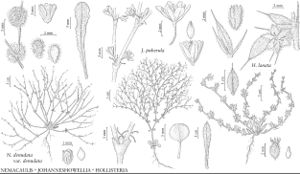Nemacaulis
Proc. Acad. Nat. Sci. Philadelphia 4: 18. 1848.
| Taxon | Illustrator ⠉ | |
|---|---|---|
 | Nemacaulis denudata var. denudata Johanneshowellia puberula Hollisteria lanata |
Herbs annual; taproot thin. Stems arising from the root, prostrate to spreading or erect, glabrous to glandular or lanate. Leaves persistent through anthesis, essentially basal, rosulate; petiole indistinct; blade linear to spatulate, margins entire. Inflorescences terminal, cymose; branches mostly dichotomous, not brittle or disarticulating into segments, round, glabrous or sparsely lanate, sometimes glandular, secondary branches sometimes developing tardily; bracts 3, connate basally, triangular to obovate, leaflike or scalelike, not awned, glabrous or glandular. Peduncles erect, slender, or absent. Involucral-bracts obscure to obvious, in tight spiral, linear to lanceolate or narrowly ovate, not awn-tipped. Flowers 5–30 per involucre, sessile or pedicellate; perianth white to rose, campanulate when open, narrowly urceolate when closed, glabrous or with gland-tipped hairs; tepals 6, connate proximally, slightly dimorphic, entire; stamens 3; filaments basally adnate, glabrous; anthers pink to red, oval. Achenes mostly included, brown to deep maroon or black, not winged, 3-gonous, glabrous. Seeds: embryo curved.
Distribution
sw United States, nw Mexico
Discussion
Species 1.
Nemacaulis is allied to Eriogonum subg. Ganysma and especially E. gossypinum. Like that species, N. denudata has flowers embedded in a dense mass of hairs, which is the only significant feature that the two have in common aside from being annuals, generally spreading in habit, and having rather densely pubescent stems and leaves. The flowers in Nemacaulis are arranged in glomerules, a feature unique in Eriogonoideae. The involucre is markedly different, being composed of several whorls of bracts, each of which subtends a flower. In this and all the other members of Eriogoneae, modification of the involucre appears to be a significant factor in the evolution of distinctive genera. In Nemacaulis, the entire glomerule is dispersed by on-shore breezes along the coast, an effective transport mechanism for the tiny seeds. Entire glomerules may be trapped in moist pockets of sand, thereby positioning several seeds in a favorable location. In the rapidly evolving derived annuals of Eriogonineae, any selective advantage is quickly adopted and survival enhanced in the rather harsh environment, where members of the subtribe abound.
Selected References
Lower Taxa
"/2" is not declared as a valid unit of measurement for this property.